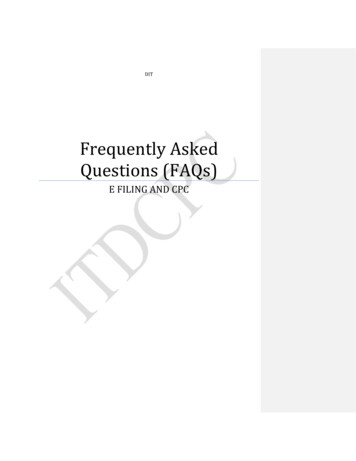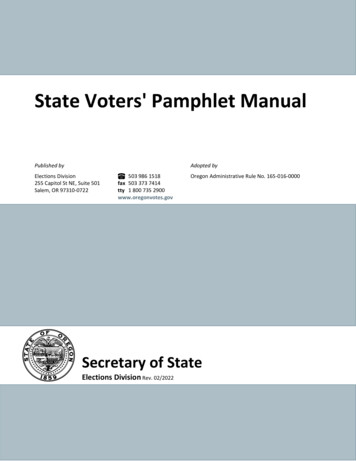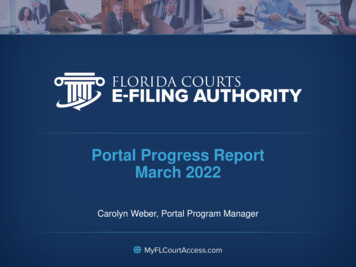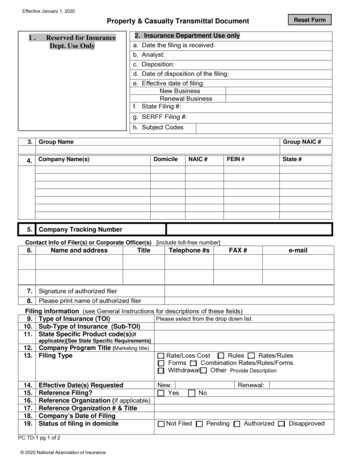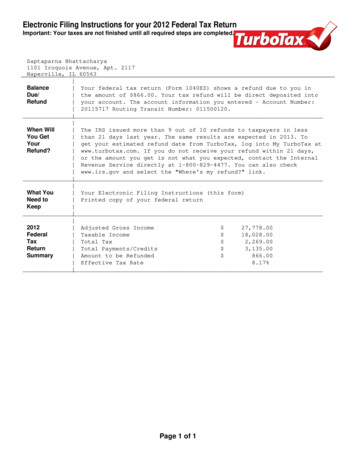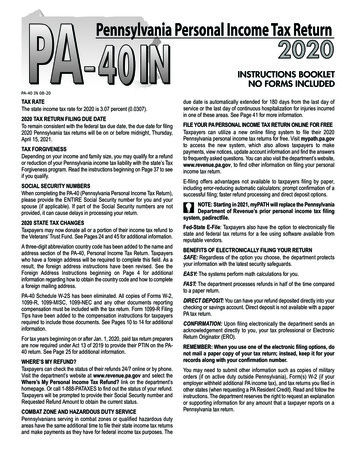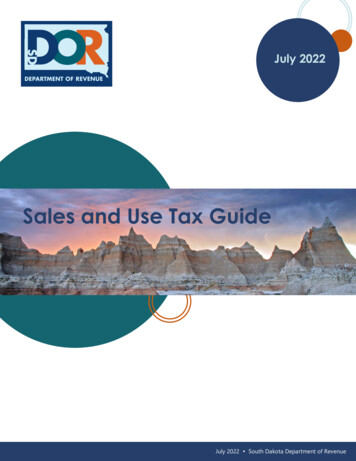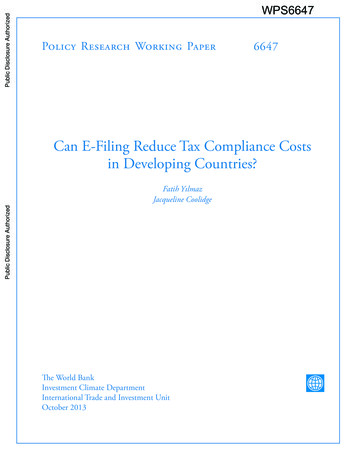
Transcription
Public Disclosure AuthorizedPolicy Research Working PaperPublic Disclosure Authorized6647Can E-Filing Reduce Tax Compliance Costsin Developing Countries?Fatih YılmazJacqueline CoolidgePublic Disclosure AuthorizedPublic Disclosure AuthorizedWPS6647The World BankInvestment Climate DepartmentInternational Trade and Investment UnitOctober 2013
Policy Research Working Paper 6647AbstractThe purpose of this study is to investigate the associationbetween electronic filing (e-filing) and the total taxcompliance costs incurred by small and medium sizebusinesses in developing countries, based on surveydata from South Africa, Ukraine, and Nepal. A priori,most observers expect that use of e-filing should reducetax compliance costs, but this analysis suggests that theassumption should be more nuanced. In particular,policies that require business taxpayers to submit paperbased information in addition to their e-filing roughlynegate savings that would otherwise be realized. Inaddition, adoption of e-filing requires an up-frontinvestment by the business not only in capital assets,but also in the time, effort, and resources requiredto learn how to use e-filing properly and efficiently.Small businesses, in particular, are likely to face a steep“learning curve” and should probably not be forced touse e-filing before the majority of them have access tocomputers (with reliable electricity service) and have hada chance to become familiar with both computer use andthe Internet.This paper is a product of the International Trade and Investment Unit, Investment Climate Department. It is part ofa larger effort by the World Bank to provide open access to its research and make a contribution to development policydiscussions around the world. Policy Research Working Papers are also posted on the Web at http://econ.worldbank.org.The authors may be contacted at: fyilmaz@ucalgary.ca or jcoolidge@schoolbench.com.The Policy Research Working Paper Series disseminates the findings of work in progress to encourage the exchange of ideas about developmentissues. An objective of the series is to get the findings out quickly, even if the presentations are less than fully polished. The papers carry thenames of the authors and should be cited accordingly. The findings, interpretations, and conclusions expressed in this paper are entirely thoseof the authors. They do not necessarily represent the views of the International Bank for Reconstruction and Development/World Bank andits affiliated organizations, or those of the Executive Directors of the World Bank or the governments they represent.Produced by the Research Support Team
Can E-Filing Reduce Tax Compliance Costs in Developing Countries?Fatih Yılmaz and Jacqueline Coolidge** F. Yılmaz (corresponding author), fyilmaz@ucalgary.ca and J. Coolidge areconsultants with the World BankWe thank Kenneth J. McKenzie for his enormous contribution and feedback. Thisreport has also benefited from the comments of Domagoj Ilic, Richard Bird, HerbertEmery, Trevor Tombe, Ali Shajarizadeh, Jevan Cherniwchan, Jan Loeprick, BlancaMoreno-Dodson, Sebastian James, Raul Junquera, David Kloeden, and participants ina seminar at the World Bank Group on 2 May 2013, in the PhD Mini Conference atthe University of Calgary on 24 May 2013 as well as in the Annual CanadianEconomic Association meeting at the University of Montreal on 31 May 2013. Weare also grateful to WBG Investment Climate Department and Richard Stern forfunding and guidance. The opinions expressed here do not necessarily reflect thoseof the World Bank, its Executive Directors or member countries. All errors are ourown.
Can E-Filing Reduce Tax Compliance Costs in Developing Countries?1. IntroductionTax compliance costs (TCC), defined briefly as the costs of complying with taxregulations, are usually highly regressive in firm size and therefore are a notoriousburden, especially for small and medium size businesses (SMEs). 1 By reducing thesecosts, firms can allocate more resources towards productive activities. 2 In thisrespect, electronic filing (e-filing) is a promising candidate that can reduce TCC fortaxpayers, by making the reporting process easier and less prone to errors andreducing visits to the tax office. 3 This paper takes the first steps to investigatewhether, and under what circumstances, the adoption of electronic filing decreasestax compliance costs (TCC) for small and medium size enterprises (SME) indeveloping countries.Superficial consideration may suggest that e-filing should reduce TCC since itsimplifies the workload of tax compliance (TC) with respect to (mainly) filling outand submitting tax forms. However, the results of this paper show that there may beoffsetting costs associated with e-filing such as additional capital that may need tobe invested to adopt e-filing, the time required to learn the system and practicalimplementation of the policy in the country. 4 In particular, a learning curveassociated with e-filing experience is evident: as firms gain more experience with efiling, they enjoy further reductions in TCC in the long-run. However, the curve isconcave, which simply implies that the learning effect diminishes over time. 5 Ourinterpretation of this result is that e-filing can potentially decrease TCC in the long1 Sanford (1994 and 1995), James (2003), Evans (2003) and Coolidge (2012) provide detailed literature reviewsand empirical findings.2 Government of New Zealand (2007), Gatti and Honoratti (2008), and OECD (2008) discuss benefits that couldbe generated from reducing tax compliance cost for small and medium size firms.3 Che Azmi, et. al., (2010); E-filing may also reduce tax-administrating costs for the public sector (see, e.g., IFC2012) although, these are not discussed here.4 E.g. whether the policy was enforced or optional; whether the policy replaces the old paper filing or requiresdouble filing.5 Nevertheless, this effect was only captured in the South African case due to limitations in data from othercountries.2
run although such reduction in TCC should not necessarily be expected in the shortterm.More specifically, we start the analysis with a critical discussion of thedifferent policy experiences in South Africa, Nepal and Ukraine 6 and then providesome theoretical basis to illustrate how e-filing can be related to and is potentiallyexpected to decrease TCC. In order to provide a more comprehensive understandingof the relation between e-filing and TCC, we focus on two questions in thedescriptive analysis: “Who are e-filers?” and “How much does TCC differ between e-filers and non-e-filers?” To answer the first question, a detailed discussion on thecorrelation between firms’ characteristics and e-filing decisions is provided. Then,our focus was on the differential in TCC incurred by e-filers versus non e-filers toanswer the second question. Following the simple descriptive analysis, weundertake a more rigorous regression analysis to estimate the likelihood of e-filingusage by controlling for many firm characteristics that are found to be important fore-filing decisions in the descriptive analysis. Finally, we estimate the effect of e-filingusage on TCC in a regression setup.Our results show that the answer to the question of the focus is: “it depends”.In countries where e-filing replaces paper-based filing with no additional workrequired from firms, as was the case in South Africa, e-filing is associated with somesavings in TCC. On average 22.4% reduction in overall TCC and 21.8% reduction inhours spent for complying with VAT are associated with e-filing usage in SouthAfrica. Yet, this reduction does not always occur in overall TCC but in a few relevantcomponents. It is therefore not clear whether one can always expect a statisticallysignificant reduction in overall TCC or not. 7 In fact, the policy implementation of e-filing is very important for the effectiveness of the system in decreasing TCC andmay actually fail to achieve its intended objective. For instance, we estimate about a34% increase in TCC associated with e-filing usage in Nepal, where the policy wasmandatory for all firms. Additionally, perception and trust of the electronic system6 TCC surveys from these countries are used in the analysis, which provide sufficient information for thepurpose of this research.7 One reason for this could be measurement error or underreporting.3
is also important for the efficiency of the policy. E-filing was not mandatory inUkraine, however our estimates from this country show that an increase in TCC isassociated with e-filing usage up to 25%. This should not be too surprising as mostSMEs performed double filing in the country, due to lack of trust on the onlinesystem, although paper filing was not required. We provide a detail analysis on all ofthese in the following sections.Firm level cross sectional survey data sets with quite detailed information onfirm characteristics were used in this analysis. Our identification strategy andrelated assumptions are discussed below. We were critical about many potentialsources of endogeneity and especially careful about self-selection. Nevertheless, ourresults should be taken suggestive rather than strict causality.In what follows, the differences in policy implementation across countries anddata coverage in each survey are provided along with a discussion on theoreticalbackground and empirical identification. In section 2, we present a descriptiveanalysis of each data set from all three countries separately. Section 3 sheds furtherlight on the hypothesis from regression analysis and Section 4 concludes withresearch findings.1.1 Policy Implementation and Survey CoverageThe analysis here is based on the experience of three countries: South Africa,Nepal, and Ukraine. 8 As each country has had different policy experiences, it isimportant to discuss these differences, including policy implementation and otherdetails about the survey coverage, while doing the analysis.In South Africa, e-filing was introduced in 2003, but initially only for valueadded (VAT) and employment taxes. E-filing for income taxes for companies andindividuals followed in 2006. According to the policy implementation in the country,e-filing is voluntary and e-filers are not required to file paper returns once theprocess is completed electronically. An important consideration is that the TCC8 TCC survey has been conducted for 12 developing countries although only three of these countries providesufficient information for our analysis. See Coolidge (2012) fur further details on some of the data for excludedcountries.4
survey for SME taxpayers in South Africa was performed in 2007 with a focus on theprevious fiscal year, 2006 (USAID, 2008). This may weaken the identification ofbenefits from the reform with respect to income taxes, although the benefits from efiling should have been long realized by VAT and employment tax payers.In Nepal, the implementation of the system was quite complex. Firms werereportedly required to complete a tedious amount of paper work for their electronicreports to be accepted by the revenue agency, which may increase TCC. The e-filingwas legally required, but not comprehensively enforced, and many firmscomplained about poor IT connectivity. Additionally, e-filing was introduced in the2009/2010 fiscal year, while the TCC survey was done in 2011, focusing on fiscal taxyear, 2009/2010 (IFC, 2012). This can be problematic for the analysis of such datasince it was the first year of policy practice, and businesses that used it were still inthe process of learning-by-doing.The Ukrainian government introduced a full e-filing system in 2006 on avoluntary basis, and e-filers were not legally required to submit hard copies of theirtax returns. However, certain “background documents” had to be submitted in hardcopy; although they could be sent by registered mail, most private sector taxpayersreportedly did not trust the system and the survey showed that the vast majorityreported that they had brought their hard copies to the State Tax Committeephysically. In addition, SMEs had only one year of e-filing experience prior to thesurvey (IFC, 2009), which might not have been a sufficient period for “learning bydoing” to gain all the benefits. It is likely that a survey conducted shortly after theintroduction of e-filing may not be able to provide a complete picture of the mediumto long run effects of e-filing on TCC.1.2 Theoretical Thinking and Empirical IdentificationIt is important to identify the mechanisms through which e-filing might affectTCC. To address this, we present a very simple theoretical illustration. This is by nomeans intended to represent a theory of tax compliance, but rather to focus on thebasics to clarify the underlying thought process we have in mind. To begin, we thinkfrom the perspective of firms. Say the TCC can be written as TCC f(s,e,g), where5
TCC is assumed to be function of firm specific factors (s), group specific factors (e)and government policy implementation (g). Among firm specific factors, one mayinclude turnover, employment, management quality, productivity (of employees andtax staff), firm’s experience with taxes etc. With the exception of managementquality, these are observable factors that are specific to each firm. The location offirms, the industry that they operate in and legal form are group specific factors,which affect all the firms in the same group similarly. E-filing policyimplementations including corruption, informalities in conducting the policy orrequiring double filing are examples for the government side of the story.The equation (below) simply states that change in TCC (ΔTCC) is equal tochanges in compliance costs associated with e-filing given all specific factors less thecost of adopting it (c(capital, labor)). The cost of adopting e-filing is written as(c(capital, labor)) and is modeled in two parts: the first part is the capitalinvestment such as cost of registering, software, computers, maintenance etc., andthe second part is training accounting staff to use the system. These costs includefixed and variable costs over time. Now, one can write the effect of e-filing on TCC asΔTCC [f(s,e,g efile 1) - f(s,e,g efile 0)] c(capital, labor).The first term is the cost savings associated with e-filing and is presumably (apriori) negative (i.e. e-filers pay less TCC relative to non e-filers, holding everythingelse constant) and the second term, cost of adopting e-filing, is positive. The firstterm is simply a necessary condition of our theoretical framework but is notsufficient to claim that e-filing will indeed decrease TCC. Sufficient condition requiresthe negative effect to be bigger than the positive one in magnitude. Net change inTCC (ΔTCC) thereof depends on which effect dominates. Since we do not havedetailed data on the cost of adopting e-filing, we are forced to assume that this ismore or the less same across all firms. Nevertheless, this may not be always true. Amore appealing setup would certainly be a dynamic one to understand thetransitions in the short and long runs. Simply, adoption cost will diminish over timeand also, as firms gain experience with the system, they benefit more from it. Put6
differently, over time the benefits from e-filing (assuming perfect policyimplementation) will increase while the costs diminish.In a perfect world, one can estimate the average effect of e-filing (the firstpart of the equation) by conducting a controlled experimental design, where somefirms (regardless of their characteristics) are randomly assigned to use e-filingwhile others (the control group) are assigned to not use it. In this way, one couldsimply go around the self-selection problem 9 by disentangling the decision ofadopting e-filing and firm characteristics. Following the first step, one could thenundertake a very simple regression analysis to estimate the average “causal effect”of using e-filing on TCC. In a world of empirical data lacking an experimental design,one needs to control for all firms’ characteristics, especially the ones that areparticularly important for the decision of e-filing usage, to overcome the selectionproblem. Following the first step, one can then estimate the average effect of e-filingon TCC in a more complex regression setup. This could best be done in a panel setupby using firm’s fixed effects (including time invariant unobserved firmcharacteristics) and time trends in the regression model. The time frame is alsoimportant to understand the short-run versus medium to long-run impacts of usinge-filing.As we have, so far, only cross sectional firm level data sets, we are not in aposition to apply the first two methods. However, using the data available to us, wecan control for many firm characteristics such as turnover, employment,productivity, taxes paid by firms, bank accounts (formality in doing business) etc.,and also, can control for industry, location and legal form of firms. As the analysis isdone for each country separately, the government policy generally should havesimilar effects on all firms in the same country (although firms’ perceptions orexperience with informalities generated by government officials within a countrymay be different). Finally, there are some perception variables, which can be used asproxies for governance quality and the efficacy of policy implementation at the firm9 See Heckman, J. James (1979, 1990) and also for a recent reference, see Jacobs, Hartog and Vijverberg (2009)for further details. There are different types of selection bias problems, the one that is particular concern to ushere is the possibility of a group of firms with certain types of characteristics (that are not observable in thedata) self-selecting themselves to e-file.7
level. Such consideration will enable us to address the self-selection and other typesof endogeneity problems. However, our results should be interpreted as identifyingthe “association” between the variables of interest rather than a strict “causation,”which requires a deeper consideration with a richer data set (e.g. experimentaldesign). 10 Further discussion on these issues is provided in the regression analysissection.2. Descriptive AnalysisIn this section, we seek answers to a series of questions such as “Who are e-filers?”, “Is there a certain pattern behind such behavior?”, “Does this behavior differacross countries?” Secondly, we perform several mean comparison tests to check ifmean TCC paid by e-filers is statistically different than mean TCC for non-e-filers.2.1 Who Are E-filers?The descriptive analysis for South Africa, Nepal and Ukraine outlines severalpatterns that are important in firms’ e-filing decisions: firms that are located indeveloped regions, relatively larger in size, under relatively more complex legalforms, paying higher taxes, operate in relatively more capital intensive industries(e.g. finance and consulting service) are more likely to sign up for e-filing relative toothers.Infrastructure development is quite important not only for firms’ e-filingdecisions but also for using the system effectively. The reliable availability ofinternet access and electricity, capability in computer usage, awareness of e-filing orbeing informed about the process are part of what we label “infrastructure”. In fact,according to the information provided in the surveys, firms rank these issues at thetop of the list of reasons for “why they do not sign up for e-filing.” 11 Moreover, thedescriptive analysis shows that firms operating in relatively more developed cities10 There are also other methods available to address the self-selection problem, such as Heckman Correctionand/or Propensity Score Matching methods. The former requires an exogenous identification criteria and thelatter requires a large data set to obtain sufficient number of matches. Due to data limitations in size andcoverage, both approaches are beyond the capability of this report.11 For instance, in Nepal, lack of information about the system among firms was the most frequently mentionedreason for not e-filing.8
are more likely to use e-filing. This is not a country specific finding; rather issupported by the evidence from all countries considered in the analysis.Firm size is important. Relatively larger firms, operating more professionally,tend to employ staff dedicated to accounting and tax, and are exposed to the usageof technology relatively more than smaller firms. These characteristics may allowlarge firms to adopt e-filing more conveniently or at least to use it more efficiently.On the other hand, firms that are larger in size are generally subject to more taxessuch as corporate income taxes (CIT), value added taxes (VAT), payroll taxes (PAYE)and so on. In this respect, e-filing – if it indeed simplifies tax compliance in practice –may benefit larger firms more than smaller firms. As such, larger firms simply havemore means to use e-filing and this claim is supported in the data. Firm size ismeasured by turnover as well as by the number of workers, and in both cases wefind a positive correlation between firm size and e-filing decisions.The legal structure of the firm and the number of taxes it pays are positivelycorrelated with firm size. Legal form is therefore also positively correlated with efiling decisions of firms. Put differently, micro firms usually operate as soleproprietorships, where they are either subject to a simplified tax regime (as inUkraine’s case), are under the VAT threshold or are not even legally required to paycertain taxes. Therefore e-filing may offer very little reduction in their TCC, whileadoption of e-filing can be quite expensive and require computer skills that theymay not have. In this respect, we find that firms operating under relatively morecomplex legal forms such as partnerships and corporations (LTD) are more likely toadopt e-filing.Different industries may also require different skill sets. For instancefinancial industry, professional services and trade-oriented industries may alreadydemand more technology usage from firms. Firms operating in these industriesmight already use computers, internet, and high skilled labor in their operations,which allow them to enjoy “economies of scope” in case of adopting e-filing. Thissimply means adopting e-filing may be easier or cheaper for these firms. In fact, thisclaim is supported by the analysis undertaken here: that is, firms operating in such9
sectors are more likely to adopt e-filing relative to other firms operating in lesstechnology oriented sectors such as agriculture.Details of the descriptive analysis are extensively discussed below by relyingon the experience of three different countries. As data availability allows, weprovide empirical evidence for each of these claims. We start with South Africa andthen proceed in the order of Nepal and Ukraine.2.1.1 South AfricaAs of the 2006 fiscal year, 32% of the firms had signed up for e-filing in SouthAfrica. Over 60% of all e-filers, which constitute 20% of the firms in the total sample,are located in the heavily urbanized (or relatively more developed) provinces of thecountry: Gauteng and the Western Cape. 12 The remainder is located in the otherseven provinces. As Figure S1 shows e-filing usage among firms in the moreurbanized provinces is relatively more common relative to the other provinces.12 According to the development report by the South African National Planning Commission in 2010, these arethe two most developed provinces of the country.10
According to the survey, only 27 % of e-filers are in the lowest three turnover bands.In contrast, e-filers located in the highest three turnover bands constitute 66% oftotal e-filers in the country. Cross tabulations of this figure only for firms located inGauteng or Western Cape present similar patterns. As expected, and as Figure S2shows, firms generating relatively higher turnover tend to use e-filing morefrequently compared to those in lower turnover bands. The total number of workersmay also be used as a proxy for firm size. To consider this, the weighted average ofthe total number of workers hired by e-filers and non-e-filers are compared; whichshows that on average firms with more workers are more likely to sign up for efiling. 1313 The mean difference is statistically significant according to all conventional levels.11
Firms’ legal form and their e-filing decisions are presented in Figure S3. Itshows that e-filing is more common among partnerships and companies (PTY LTD)compared to other legal forms.12
Similar to legal structure, different taxes may incentivize firms differentlywith respect to using e-filing. Given that the e-filing system was first introduced forVAT and employment taxes (PAYE, UIF and SDL) in 2003, and only later, in 2006, forincome taxes (CIT and PIT), it is not surprising to see a slightly higher percentage ofVAT and employment tax payers using e-filing (in Table 1) relative to other majortaxes. Since most sole proprietorships pay PIT, PIT payers record the lowestpercentage of e-filing usage.It should be noted that signing up for e-filing does not always imply theactual usage of the system in practice. In fact, usage of the system varies acrossdifferent taxes. For instance, as shown in Figure S4, about 46 % of e-filers use thesystem for all four main taxes in Table 1. 14 Firms using the e-filing system for onlythree of these taxes constitute 32 % of e-filers. This implies that 78 % of e-filers(25% of the total sample) report at least 3 of 4 main taxes electronically. Amongthese taxes, VAT and PAYE are the most commonly reported electronically (88 %and 85 % of all e-filers respectively).14 In the survey, CIT and PIT are grouped under “income taxes” and UIF and SDL are also considered as onegroup.13
Table 2 provides the distribution of e-filing usage over the four mainindustries, which accounts for 75% of total e-filers in South Africa. These fourindustries alone include 66% of all the firms in the country. A closer look at theseindustries (in Figure S5 below) showsthat firms in finance, real estate and thebusiness services industry are more likelyto sign up for e-filing compared to firmsin all other industries (47%). Between 29% and 34 % of firms in manufacturing, professional services and wholesaleindustries use e-filing.14
2.1.2 NepalAccording to the TCC Survey done in 2011 focusing on 2009/2010 fiscal yearin Nepal, only 16 % (159) of firms (out of 990 firms in the representative sample)had signed up for electronic filing. 15 Since it was the first year of the policy in thecountry, participation appears to be low, and it is likely that many firms thatoutsource their tax compliance may not even be aware of whether their professionalaccountants are using e-filing for their tax returns. 16 E-filers are mainly located inthe Central Region (55% of all e-filers), particularly in the capital city Kathmandu(48% of all e-filers). Besides the importance of infrastructural development in thepractice of e-filing, in Nepal, agglomeration associated with the presence of many efilers in Kathmandu may be due the fact that it was the first year of the policy. A lookat firm location and e-filing usage shows that 45.4 % of the firms located inMahendranagan (which corresponds only to 4% of all the firms in the country) havesigned up for e-filing. This number is 20 % in Kathmandu (Figure N1), while e-filers15 After considering the sampling weights.16 In fact, e-filing was officially mandatory in 2011 but apparently not consistently enforced.15
in Kathmandu constitute 16 % of the total population. The rate of e-filingparticipation for firms located in all other cities is only 7.5 %.As discussed before, firm size is important in e-filing decisions, and thisappears to be the case in Nepal as well, given that it is a very common practiceamong firms in the highest four turnover bands. For instance, while 65 % of firms inturnover band “Nrs 10,000,000 to Nrs 50,000,000” using e-filing, this figure reachesto 97 % in the highest turnover band. This shows that (in Figure N2) there is almosta monotonic increase in the number of e-filers when moving from very low turnoverbands to higher bands; in particular, the lowest turnover band has no e-filing users.Moreover, above the VAT registration threshold (at or above NRs 2,000,000) thereis a drastic jump in the usage of e-filing. As recorded by the IFC Survey Report forNepal, (WBG(2012)) average estimated TCC for VAT is the highest among all majortaxes in the country. This may imply that there is relatively high prospective costsavings in TCC for VAT payers from utilizing e-filing and this may explain the drasticjump in the usage of e-filing above the VAT threshold. It is also worth noting that a16
mean comparison test between the total number of workers hired by e-filers andnon-e-filers –as another size measure– confirms the hypothesis: firms with arelatively higher number of workers are more likely to sign up for e-filing. This isstatistically significant at all conventional levels.Out of 990 firms surveyed in Nepal, 875 of them are sole proprietorships, whichcorresponds to 88% of the population in Nepal. Looking at the e-filing rate amongfirms operating under various legal forms shows that only 12% of soleproprietorships use e-filing while this figure is 94% for public limited companies(Figure N3).17
Similarly, most of the private limited companies (about 61% of the group) alsoprefer electronic filing. This is in line with the earlier observation that firms withmore complex legal structures are more likely to register for e-filing.In Table N1, differenttaxes paid by firms, and firms’ efilingstatusarepresented.According to the data, all of thefirms in the sample pay CIT. Yet,only 16% of them are registered for e-filing. Moreover, this number for VAT payersis 51% and for
the Internet. Can E-Filing Reduce Tax Compliance Costs in Developing Countries? Fatih Yılmaz and Jacqueline Coolidge* * F. Yılmaz (corresponding author), . 2009/2010 fiscal year, while the TCC survey was done in 2011, focusing on fiscal tax year, 2009/2010 (IFC, 2012). This can be problematic for the analysis of such data
